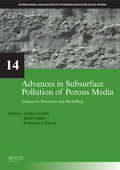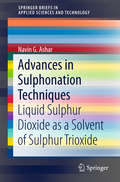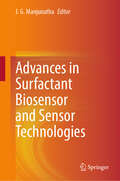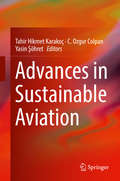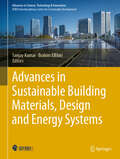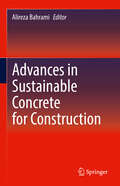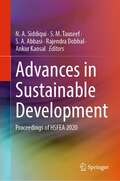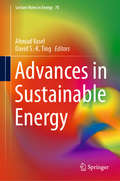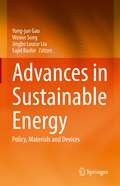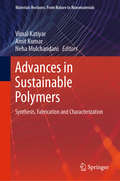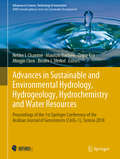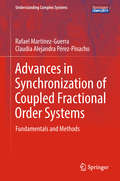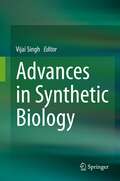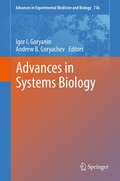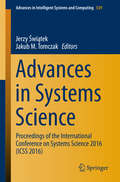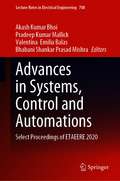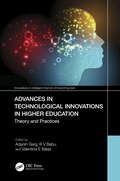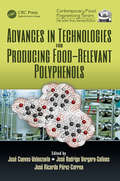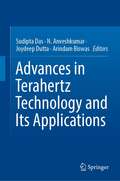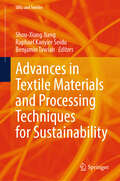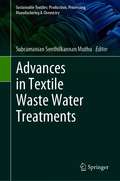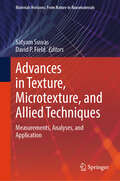- Table View
- List View
Advances in Subsurface Pollution of Porous Media - Indicators, Processes and Modelling: IAH selected papers, volume 14 (IAH - Selected Papers on Hydrogeology)
by Lucila Candela Francisco Javier Elorza Iñaki VadilloAdvances in Subsurface Contamination of Porous Media: Indicators, Processes and Modelling provides a high level understanding of the processes concerning common and emergent contaminants through their passage from soil to groundwater. The book presents new methodologies and indicators to reach a better understanding of biogeochemical proc
Advances in Sulphonation Techniques: Liquid Sulphur Dioxide as a Solvent of Sulphur Trioxide (SpringerBriefs in Applied Sciences and Technology #151)
by Navin G. AsharThis book presents a complete, in-depth analysis for on the impact of liquid sulfur dioxide and liquid sulfur trioxide to carry out complex and difficult sulfonations, as well as manufacture of sulfuric acid with a CAPEX requirement of less than half, an area requirement less than one-third, and no emission of sulfur dioxide. The processes described in this volume represents an innovative approach relevant to the current manufacturing processes of sulfuric acid, sulfamic acid, para toluene sulfonic acid and other sulfonated product.
Advances in Surfactant Biosensor and Sensor Technologies
by J. G. ManjunathaThis book presents an overview of the development and applications of surfactant biosensor technologies. The progress in this field is fueled by a need for efficient, low cost, stable sensors that utilize harmless materials; this book illustrates how surfactant sensors represent a timely solution to this issue. Readers will learn how to utilize surfactants to make green electrochemical sensors with high stability, sensitivity, selectivity, and a robust, fast response, with special emphasis given to the most recent advances in this field. The book additionally details how to apply these sensors in routine analyses authored by experts in their respective fields. Contributing authors pay close attention to the use of surfactant-based electrochemical sensors in electrodes and devices, examining their applications towards a variety of medicinal, industrial, and environmental applications. This book is an important resource for scientific researchers both specifically in the electrochemistry field, and also for those in interdisciplinary chemistry, biology, physics, and electronics fields. It invites scientists from all areas to participate, with the goal of producing more researchers developing innovative sensor technologies. It will also be beneficial for students and future scientists working on sustainable sensors.
Advances in Sustainable Aviation
by C. Ozgur Colpan Tahir Hikmet Karakoç Yasin ŞöhretThis book provides different engineering, management, economic solutions and methodologies regarding sustainable aviation, giving readers a great sense of how sustainable aviation works at the "systems" level. The aviation industry is one of the fastest growing in the world and can make a positive contribution to sustainability. This book presents environmental policies and their application to the aviation industry and evaluates solutions provided to address pollution. Chapters discuss novel technologies that the aviation industry can apply to reduce its environmental impact and become more energy efficient.
Advances in Sustainable Building Materials, Design and Energy Systems (Advances in Science, Technology & Innovation)
by Sanjay Kumar Brahim ElBhiriThis book is a great opportunity to make the research community discuss the dangerous environmental challenges such as climate change and its huge effects in addition to the world's reliance on fossil fuel and non-renewable resources. In recent years, the authors have been focused on the advancements of technology and how it can improve our lives, but the authors often overlook the fact that it is creating an unsustainable approach that comes at a high cost which makes a sustainable approach to cities necessary, focusing on accessible public transport, energy, water, and food security, and regenerating compact fabric areas. To discuss how to reach this sustainable approach, IEREK held the Advances in Energy Research, Materials Science and Built Environment (EMBE) conference from October 3 to 4, 2024, with attendees from all over the world. It provides an opportunity to exchange ideas and solutions on urban planning, sustainable architecture, climate change mitigation, and innovative design. The EMBE conference hosts a variety of knowledgeable keynote speakers and researchers who discussed the integration of technology in sustainable urban planning, green urbanism, preservation of coastal areas, innovative renewable materials, and responsive architecture. The book covers a wide range of scientific knowledge that can lead humanity toward a sustainable and greener future.
Advances in Sustainable Concrete for Construction
by Alireza BahramiThis book offers groundbreaking insights into transforming the concrete industry with innovative, environmentally conscious solutions. It explores the latest advancements in sustainable technologies, including climate-improved concrete, green binders, recycled materials, and high-performance composites. It also covers the optimization of reinforced concrete structures, load-bearing columns and beams replacements, as well as non-destructive testing methods for predicting concrete performance. Additionally, it investigates engineered cementitious composites, internally cured concrete, and industrial by-products to address pressing environmental challenges in construction. An indispensable reference for engineers, architects, and researchers shaping the future of sustainable infrastructure and reducing carbon footprints
Advances in Sustainable Construction Materials: Select Proceedings of ASCM 2020 (Lecture Notes in Civil Engineering #124)
by Sanjay Kumar Pijush Samui Sabyasachi Biswas Subhadeep MetyaThis book presents select proceedings of National Conference on Advances in Sustainable Construction Materials (ASCM 2020) and examines a range of durable, energy-efficient, and next-generation construction materials produced from industrial wastes and by-products. The topics covered include sustainable materials and construction, innovations in recycling concrete, green buildings and innovative structures, utilization of waste materials in construction, geopolymer concrete, self-compacting concrete by using industrial waste materials, nanotechnology and sustainability of concrete, environmental sustainability and development, recycling solid wastes as road construction materials, emerging sustainable practices in highway pavements construction, plastic roads, pavement analysis and design, application of geosynthetics for ground improvement, sustainability in offshore geotechnics, green tunnel construction technology and application, ground improvement techniques and municipal solid waste landfill. Given the scope of contents, the book will be useful for researchers and professionals working in the field of civil engineering and especially sustainable structures and green buildings.
Advances in Sustainable Development: Proceedings of HSFEA 2020
by S. M. Tauseef S. A. Abbasi N. A. Siddiqui Rajendra Dobhal Ankur KansalThis book comprises selected papers on advances in the field of health and environment safety that were presented at the International Conference on Advances in the field of Health, Safety, Fire, Environment, Allied sciences and engineering (HSFEA 2020). This book presents a number of research papers which focuses on basic concept of sustainable development and its role in modern world for clean development technology. The book also presents methods that can be used to effectively monitor and measure climate change and global warming. Further, the contents of this work stress the importance of maintaining safety and healthy work environments that are free of occupational health hazards. This book will be of interest to researchers, professionals, and policy makers alike.
Advances in Sustainable Energy (Lecture Notes in Energy #70)
by Ahmad Vasel David S-K. TingThis book reveals key challenges to ensuring the secure and sustainable production and use of energy resources, and provides corresponding solutions. It discusses the latest advances in renewable energy generation, and includes studies on climate change and social sustainability. In turn, the book goes beyond theory and describes practical challenges and solutions associated with energy and sustainability. In particular, it addresses: · renewable energy conversion technologies; · transmission, storage and consumption; · green buildings and the green economy; and · waste and recycling. The book presents the current state of knowledge on renewable energy and sustainability, supported by detailed examples and case studies, making it not only a cutting-edge source of information for experts and researchers in the field, but also an educational tool for related undergraduate and graduate courses.
Advances in Sustainable Energy: Policy, Materials and Devices
by Sajid Bashir Jingbo Louise Liu Yong-Jun Gao Weixin SongThis books provides a comprehensive platform to the scientific, education and research communities working on various fields related to sustainable energy. It covers the exploration, generation and application of this area to meet societal needs as well as addressing global issues related to the environment. The content of this book presents research related to energy and how to tackle climate change as a comprehensive framework based on the success of the Millennium Development Goals (MDGs). The authors use the scientific method to analyze and deliver viable technical solutions, demonstrating how chemistry and engineering can be combined to solve technically challenging problems. While maintaining high scientific rigor, a quantitative approach is offered in select chapters to the study of energy related to our societies increasing need for electrical and chemical energy feedstocks.
Advances in Sustainable Polymers: Processing and Applications (Materials Horizons: From Nature to Nanomaterials)
by Vimal Katiyar Raghvendra Gupta Tabli GhoshThis book provides a systematic overview of the processing and applications of sustainable polymers. The volume covers recent advances in biomedical, food packaging, fuel cell, membrane, and other emerging applications. The book begins by addressing different sections of biomedical application including use of carbohydrate-based therapeutics, nanohybrids, nanohydrogels, bioresorbable polymers and their composites, polymer-grafted nanobiomaterials for biomedical devices and implants, nanofibres, and others. The second part of this book discusses various processing and packaging materials for food packaging applications. The last section discusses other emerging applications, including using microbial fuel cells for waste water treatment, microfluidic fuel cells for low power applications, among others. This volume will be relevant to researchers working to improve the properties of bio-based materials for their advanced application and wide commercialization.
Advances in Sustainable Polymers: Synthesis, Fabrication and Characterization (Materials Horizons: From Nature to Nanomaterials)
by Amit Kumar Vimal Katiyar Neha MulchandaniThis book discusses synthesis and characterization of sustainable polymers. The book covers opportunities and challenges of using sustainable polymers to replace existing petroleum based feedstock. This volume provides insights into the chemistry of polymerization, and discusses tailoring the properties of the polymers at the source in order fit requirements of specific applications. The book also covers processing of these polymers and their critical assessment. The book will be of use to chemists and engineers in the industry and academia working on sustainable polymers and their commercialization to replace dependence on petroleum-based polymers.
Advances in Sustainable and Environmental Hydrology, Hydrogeology, Hydrochemistry and Water Resources: Proceedings of the 1st Springer Conference of the Arabian Journal of Geosciences (CAJG-1), Tunisia 2018 (Advances in Science, Technology & Innovation)
by Mingjie Chen Helder I. Chaminé Maurizio Barbieri Ozgur Kisi Broder J. MerkelThis book comprises the selected papers from the 1st Springer Conference of the Arabian Journal of Geosciences (CAJG-1), Tunisia 2018. The volume is of interest to all researchers and practitioners in the fields of Hydrology, Hydrogeology, Hydrochemistry, Water Resources and Hydrologic Engineering. Water is a dynamic, finite, and vulnerable but resilient natural resource to be protected in an environmentally sustainable manner. Water systems in different frameworks requires a comprehensive understanding of climatology, geology, hydrogeology, hydrochemistry, hydrodynamics, and surface hydrology. In addition, it is highlighted the role of the variability and climate change in water systems. Furthermore, water has a vital significance to the entire socio-economic sector. This volume offers an overview of the state-of-the-art related to water science and technology in model regions in Europe, Africa, Middle East, Asia and America, but mainly focuses on the Mediterranean environment and surrounding regions. It gives new insights on characterisation, evaluation, quality, management, protection, modelling on environmental hydrology, groundwater, hydrochemistry, sustainable water resources studies and hydrologic engineering approaches by international researchers. Main topics include: 1. Hydrology, Climatology and Water-Related Ecosystems2. Hydrochemistry and Isotopic Hydrology3. Groundwater Assessment and Management: mapping, exploration, abstraction and modelling4. Water Resources Sustainability and Climate Change5. Hydrologic Engineering and Urban Groundwater
Advances in Synchronization of Coupled Fractional Order Systems: Fundamentals and Methods (Understanding Complex Systems)
by Rafael Martínez-Guerra Claudia Alejandra Pérez-PinachoAfter a short introduction to the fundamentals, this book provides a detailed account of major advances in applying fractional calculus to dynamical systems. Fractional order dynamical systems currently continue to gain further importance in many areas of science and engineering. As with many other approaches to mathematical modeling, the first issue to be addressed is the need to couple a definition of the fractional differentiation or integration operator with the types of dynamical systems that are analyzed. As such, for the fundamentals the focus is on basic aspects of fractional calculus, in particular stability analysis, which is required to tackle synchronization in coupled fractional order systems, to understand the essence of estimators for related integer order systems, and to keep track of the interplay between synchronization and parameter observation. This serves as the common basis for the more advanced topics and applications presented in the subsequent chapters, which include an introduction to the 'Immersion and Invariance' (I&I) methodology, the masterslave synchronization scheme for partially known nonlinear fractional order systems, Fractional Algebraic Observability (FAO) and Fractional Generalized quasi-Synchronization (FGqS) to name but a few. This book is intended not only for applied mathematicians and theoretical physicists, but also for anyone in applied science dealing with complex nonlinear systems.
Advances in Synthetic Biology
by Vijai SinghThis book addresses the design of emerging conceptual tools, technologies and systems including novel synthetic parts, devices, circuits, oscillators, biological gates, and small regulatory RNAs (riboregulators and riboswitches), which serve as versatile control elements for regulating gene expression. Synthetic biology, a rapidly growing field that involves the application of engineering principles in biology, is now being used to develop novel systems for a wide range of applications including diagnostics, cell reprogramming, therapeutics, enzymes, vaccines, biomaterials, biofuels, fine chemicals and many more. The book subsequently summarizes recent developments in technologies for assembling synthetic genomes, minimal genomes, synthetic biology toolboxes, CRISPR-Cas systems, cell-free protein synthesis systems and microfluidics. Accordingly, it offers a valuable resource not only for beginners in synthetic biology, but also for researchers, students, scientists, clinicians, stakeholders and policymakers interested in the potential held by synthetic biology.
Advances in Systems Biology (Advances in Experimental Medicine and Biology #736)
by Igor I. Goryanin Andrew B. GoryachevThe International Society for Systems Biology (ISSB) is a society aimed at advancing world-wide systems biology research by providing a forum for scientific discussions and various academic services. The ISSB helps coordinate researchers to form alliances for meeting the unique needs of multidisciplinary and international systems biology research. The annual International Conference on Systems Biology (ICSB) serves as the main meeting for the society and is one of the largest academic and commercial gatherings under the broad heading of 'Systems Biology'.
Advances in Systems Science: Proceedings of the International Conference on Systems Science 2016 (ICSS 2016) (Advances in Intelligent Systems and Computing #539)
by Jerzy Świątek Jakub M. TomczakThis book gathers the carefully reviewed proceedings of the 19th International Conference on Systems Science, presenting recent research findings in the areas of Artificial Intelligence, Machine Learning, Communication/Networking and Information Technology, Control Theory, Decision Support, Image Processing and Computer Vision, Optimization Techniques, Pattern Recognition, Robotics, Service Science, Web-based Services, Uncertain Systems and Transportation Systems. The International Conference on Systems Science was held in Wroclaw, Poland from September 7 to 9, 2016, and addressed a range of topics, including systems theory, control theory, machine learning, artificial intelligence, signal processing, communication and information technologies, transportation systems, multi-robotic systems and uncertain systems, as well as their applications. The aim of the conference is to provide a platform for communication between young and established researchers and practitioners, fostering future joint research in systems science.
Advances in Systems, Control and Automations: Select Proceedings of ETAEERE 2020 (Lecture Notes in Electrical Engineering #708)
by Bhabani Shankar Prasad Mishra Valentina Emilia Balas Akash Kumar Bhoi Pradeep Kumar MallickThis book comprises select proceedings of the international conference ETAEERE 2020. This volume covers latest research in advanced approaches in automation, control based devices, and adaptive learning mechanisms. The contents discuss the complex operations and behaviors of different systems or machines in different environments. Some of the areas covered include control of linear and nonlinear systems, intelligent systems, stochastic control, knowledge-based systems applications, fault diagnosis and tolerant control, and real-time control applications. The contents of this volume can be useful for researchers as well as professionals working in control and automation.
Advances in TNF Family Research: Proceedings of the 12th International TNF Conference, 2009 (Advances in Experimental Medicine and Biology #691)
by Andrew Kovalenko David Wallach Marc FeldmannThe biennial TNF-family conferences have been held over the past 20 years, from the time that TNF was cloned. These meetings have followed the enormous progress in this field. Much is now known about the members of the TNF ligand and receptor families, their signaling proteins, mechanisms of action and cellular functions. This volume is the proceedings of the 12th TNF International Conference, held in April 2009. This conference focuses on the physiological, pathophysiological, and medical significance of these important regulators. Sessions at the meeting specifically address their involvement in immunity, development, apoptosis, autoimmunity, cancer, and infection, the normal function and pathology of the neuronal system, as well as major unresolved questions about their mechanisms of action.
Advances in Technological Innovations in Higher Education: Theory and Practices (Innovations in Intelligent Internet of Everything (IoE))
by Adarsh Garg Valentina E Balas B V BabuThe evolution of technology in education can no longer be comprehended simply by looking at the use of computers and networks. Technology is not just a supplementary tool to the conventional method of education. Education has to undergo a complete transformation with technological innovations for the sustainability of quality education as a system and not in silos. Sustainability in education also necessitates a more workable strategy to realize socially viable educational policies and practices which can focus more on personalized learning. Due to various factors like emerging technologies; changing needs of the learners; policy reforms for enhancing employability; and emphasis on uninterrupted education as in the case of the pandemic scenario of COVID-19, there is a need to steer a major transition in the education system. The education system has to be real and proficient for it to be instrumental to nurture an informed and knowledgeable society. This book on technological innovations in higher education is organized, largely, based on the diversity of higher education ecosystems that are supported by technological innovations. Various author viewpoints give insights into the full potential of technology as well as its risks in interrelated areas of higher education to work towards sustainability of value-based quality education across the globe.
Advances in Technologies for Producing Food-relevant Polyphenols (Contemporary Food Engineering)
by José Cuevas-Valenzuela, José Rodrigo Vergara-Salinas and José Ricardo Pérez-CorreaThe growing concern for human wellbeing has generated an increase in the demand for polyphenols, secondary plant metabolites that exhibit different bioactive properties. This increasing demand is mainly due to the current applications in the food industry where polyphenols are considered essential for human health and nutrition. Advances in Technologies for Producing Food-relevant Polyphenols provides researchers, scientists, engineers, and professionals involved in the food industry with the latest methodologies and equipment useful to extract, isolate, purify, and analyze polyphenols from different available sources, such as herbs, flora, vegetables, fruits, and agro-industrial wastes. Technologies currently used to add polyphenols to diverse food matrices are also included. This book serves a reference to design and scale-up processes to obtain polyphenols from different plant sources and to produce polyphenol-rich foods with bioactive properties (e.g. antioxidant, antibacterial, antiviral, anticancer properties) of interest for human health and wellbeing.
Advances in Terahertz Technology and Its Applications
by Joydeep Dutta Arindam Biswas Sudipta Das N. AnveshkumarThis book highlights the growing applications of THz technology and various modules used for their successful realization. The enormous advantages of THz devices like higher resolution, spatial directivity, high-speed communication, greater bandwidth, non-ionizing signal nature and compactness make them useful in various applications like communication, sensing, security, safety, spectroscopy, manufacturing, bio-medical, agriculture, imaging, etc. Since the THz radiation covers frequencies from 0.1THz to around 10THz and highly attenuated by atmospheric gases, they are used in short-distance applications only. The book focuses on recent advances and different research issues in terahertz technology and presents theoretical, methodological, well-established and validated empirical works dealing with the different topics.
Advances in Textile Materials and Processing Techniques for Sustainability (SDGs and Textiles)
by Benjamin Tawiah Shou-Xiang Jiang Raphael Kanyire SeiduThis book addresses the essential need for innovative materials and processing techniques in manufacturing, making it a vital resource in the increasingly critical era of sustainable production. Globally, as industries face mounting pressure to reduce their environmental and social impact, this book comes in handy as it discusses the latest innovations in materials highlighting the important role of eco-friendly biodegradable textile materials revolutions and sustainable dye developments; and examines cutting-edge processing techniques that enhance the sustainability of textile production. Techniques such as waterless dyeing, energy-efficient manufacturing processes, and the integration of smart technologies for resource management are explored in detail. Other themes focusing on natural fibres from renewable resources, recycled materials, and recent innovations in fibre technology that contribute to sustainability will be discussed. Lifecycle assessment of textile materials and processing techniques evaluating the environmental impact of textiles from production to disposal has been discussed in detail with case studies illustrating the potential for large-scale adoption. The regulatory and certification regimes for sustainable textiles have been discussed extensively considering the unique challenges of the various economic blocs. The books conclude with a thorough discussion of the perception and acceptance of sustainable textiles by consumers. The multidisciplinary approach of this book - incorporating evidence from materials science, textile engineering, environmental science, and social perspective provides a holistic discourse on sustainability, making it suitable for ESG professionals, Environmental Science, Textile Science and Engineering, as well as Material Science students of all levels.
Advances in Textile Waste Water Treatments (Sustainable Textiles: Production, Processing, Manufacturing & Chemistry)
by Subramanian Senthilkannan MuthuThe textile waste water is well known to contain many detrimental impacts in terms of its pollutants and the issues pertaining to its discharged without being untreated, or even discharged without meeting all stipulated parameters. There is an ample amount of advancements in treating textile waste water in a sustainable way and this book comprehends the same with eight insightful chapters. The aim of this book is to deal with the advances in sustainable waste water treatments with topics Conjugated Polymer Coated Novel Bio-adsorbents for Wastewater Treatment , Advanced Oxidation Processes (AOP) – Effective innovative treatment methods to degrade textile dye effluent, etc.
Advances in Texture, Microtexture, and Allied Techniques: Measurements, Analyses, and Application (Materials Horizons: From Nature to Nanomaterials)
by David P. Field Satyam SuwasThis book presents the fundamentals of texture and microtexture with the latest developments in the field and relates the same for different materials and processes. Crystallographic phase and orientation define the anisotropy of crystalline materials. In polycrystalline materials, the preferred crystallographic orientation of grain distributions, also known as (crystallographic) texture, controls the properties of materials. The evaluation of texture has been traditionally carried out by X-ray diffraction and neutron diffraction. In recent times, microtexture-based techniques have been widely used not only to examine the crystallographic texture but also to investigate the micro-mechanisms controlling the development of texture and microstructure. It has, therefore, become almost mandatory to re-visit the physical phenomenon associated with materials from the viewpoint of microtexture. The individual chapters have been written by the renowned scientists working in the respective domain. The book can be a valuable reference for researchers and professionals interested in fundamentals of texture and microtexture and allied fields.
